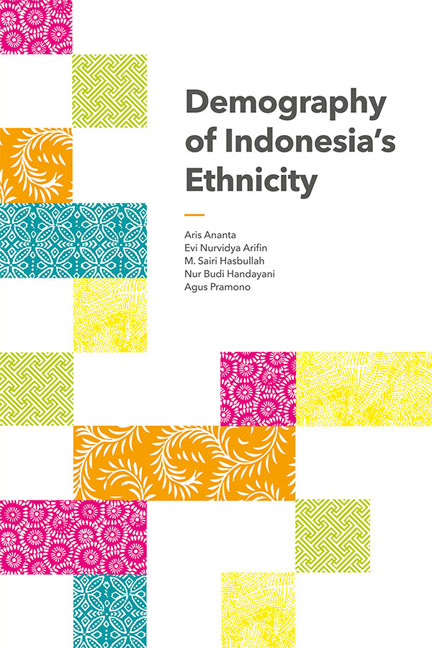Book contents
- Frontmatter
- Contents
- List of Tables
- List of Figures
- Foreword
- Acknowledgements
- 1 CHANGING INDONESIA: An Introduction
- 2 COMPLEXITY OF STATISTICS ON ETHNICITY: Concept, Data and Method of Analysis
- 3 THE NEW CLASSIFICATION: Uncovering Diversity
- 4 ETHNIC DIVERSITY: New Demographic Evidence
- 5 THE FIFTEEN LARGEST ETHNIC GROUPS: Age-Sex Structure and Geographical Distribution
- 6 CHANGE IN SIZE AND COMPOSITION OF ETHNIC GROUPS: Indonesia, 2000–2010
- 7 RELIGION AND LANGUAGE: Two Important Ethnic Markers
- References
- Appendix 1
- Appendix 2
- Index
- About the Authors
1 - CHANGING INDONESIA: An Introduction
Published online by Cambridge University Press: 10 October 2017
- Frontmatter
- Contents
- List of Tables
- List of Figures
- Foreword
- Acknowledgements
- 1 CHANGING INDONESIA: An Introduction
- 2 COMPLEXITY OF STATISTICS ON ETHNICITY: Concept, Data and Method of Analysis
- 3 THE NEW CLASSIFICATION: Uncovering Diversity
- 4 ETHNIC DIVERSITY: New Demographic Evidence
- 5 THE FIFTEEN LARGEST ETHNIC GROUPS: Age-Sex Structure and Geographical Distribution
- 6 CHANGE IN SIZE AND COMPOSITION OF ETHNIC GROUPS: Indonesia, 2000–2010
- 7 RELIGION AND LANGUAGE: Two Important Ethnic Markers
- References
- Appendix 1
- Appendix 2
- Index
- About the Authors
Summary
Indonesia, the largest country in Southeast Asia, has as its national motto “Unity in Diversity.” In 2010, Indonesia stood as the world's fourth most populous country after China, India and the United States, with 237.6 million people. This archipelagic country contributed 3.5 per cent to the world's population in the same year. Its relative contribution to the world population will be stable at around 3.4–3.5 per cent until 2050. According to the median variant of the United Nations estimate (2013), Indonesia's population will continue to grow, reaching 300 million in 2033.
The future demographics of Indonesia are likely to be very different from today's pattern, just as the current situation varies markedly from the past. Indonesians are increasingly living longer and having fewer children. Benefiting from the ease and advancement of transportation and information technology, Indonesians are increasingly more mobile, venturing into a wider labour market both within and outside Indonesia.
Indonesia has nearly completed its first demographic transition, from both high fertility and mortality to low fertility and mortality rates. The end of the first demographic transition is marked by the “replacement” level of fertility, which is the number of children a couple has that are needed to replace themselves. Population experts believe that the replacement level is reached when the fertility rate is about 2.1. However, Espenshade, Guzman and Westoff (2003) argue that the replacement rate does not occur at that rate, but relates instead to the mortality rate.
The onset of the replacement level of fertility has further implications for the ethnic composition of a population. If the replacement level can be maintained for about forty years, the population will stabilize with zero growth. However, in many cases, this is not a reality. Some regions can easily fall into below replacement fertility for so long as to threaten the population with extinction. For instance, Japan and Germany are depopulating in this way.
Some provinces in Indonesia such as Jakarta, Yogyakarta and Bali have already completed their first demographic and are now in the second demographic transition, where the fertility rate is below the replacement level. As Lesthaeghe (1991) argues, under the regime of the second demographic transition, marriage is no longer universal, occurs at older ages and can be childless. There are higher-order needs on individualization, self-actualization and a rising awareness of human rights.
- Type
- Chapter
- Information
- Demography of Indonesia's Ethnicity , pp. 1 - 15Publisher: ISEAS–Yusof Ishak InstitutePrint publication year: 2014

